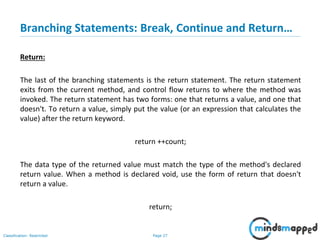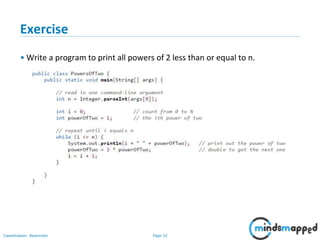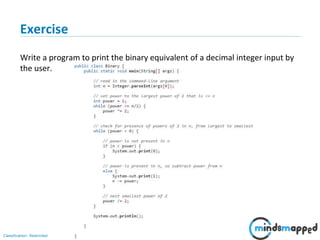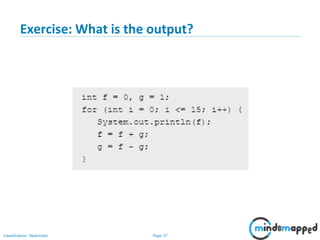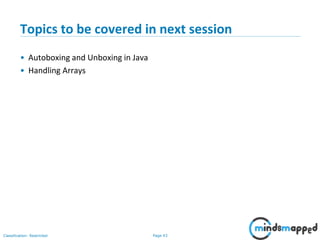Elements of Java Language - Continued
- 1. Core Java Training Elements of Java programming
- 2. Page 1Classification: Restricted Agenda • Elements of Java programming language • Conditional Statements • Loops
- 4. Page 3Classification: Restricted Conditional Statements • if • if-else • if-else ladder • switch-case • Ternary operator
- 5. Page 4Classification: Restricted If statement
- 6. Page 5Classification: Restricted if and if-else examples
- 7. Page 6Classification: Restricted if-else ladder
- 8. Page 7Classification: Restricted Ternary Operator
- 9. Page 8Classification: Restricted Switch…case statement Unlike if-then and if-then-else statements, the switch statement can have a number of possible execution paths. A switch works with the byte, short, char, and int primitive data types. It also works with enumerated types (discussed in Enum Types), the String class, and a few special classes that wrap certain primitive types: Character, Byte, Short, and Integer (discussed in Numbers and Strings). * Provide default value – it is a good practice. * The break is important. Don’t forget it.
- 10. Page 9Classification: Restricted Exercise Use Math.random() and an if-else statement to print the results of a coin flip.
- 11. Page 10Classification: Restricted Exercise Use Math.random() and an if-else statement to print the results of a coin flip.
- 12. Page 11Classification: Restricted Exercise • Write two programs - one using switch case and another using if else ladder to print the full name of a month provided that the user inputs an integer between 1 to 12. • E.g. if the user inputs 1, print January.
- 13. Loops
- 14. Page 13Classification: Restricted Loops • while • do..while • for
- 17. Page 16Classification: Restricted Exercise – what is output?
- 18. Page 17Classification: Restricted Exercise – what is the output?
- 19. Page 18Classification: Restricted Difference between while and do-while? Do-while loop is always executed at least once, as the condition is checked at the end of the loop.
- 20. Page 19Classification: Restricted for statement
- 21. Page 20Classification: Restricted Loop Examples
- 22. Page 21Classification: Restricted Branching Statements: Break, Continue and Return… Break: The break statement has two forms: labeled and unlabeled. You saw the unlabeled form in the previous discussion of the switch statement. You can also use an unlabeled break to terminate a for, while, or do-while loop An unlabeled break statement terminates the innermost switch, for, while, or do-while statement, but a labeled break terminates an outer statement.
- 23. Page 22Classification: Restricted Break statement: Example (Without Label)
- 24. Page 23Classification: Restricted Break statement: Example (With Label)
- 25. Page 24Classification: Restricted Branching Statements: Break, Continue and Return… Continue: The continue statement skips the current iteration of a for, while , or do- while loop. The unlabeled form skips to the end of the innermost loop's body and evaluates the boolean expression that controls the loop. The following program, ContinueDemo , steps through a String, counting the occurences of the letter "p". If the current character is not a p, the continue statement skips the rest of the loop and proceeds to the next character. If it is a "p", the program increments the letter count.
- 26. Page 25Classification: Restricted Continue Statement: Example (Without Label)
- 27. Page 26Classification: Restricted Continue Statement: Example (Without Label)
- 28. Page 27Classification: Restricted Branching Statements: Break, Continue and Return… Return: The last of the branching statements is the return statement. The return statement exits from the current method, and control flow returns to where the method was invoked. The return statement has two forms: one that returns a value, and one that doesn't. To return a value, simply put the value (or an expression that calculates the value) after the return keyword. return ++count; The data type of the returned value must match the type of the method's declared return value. When a method is declared void, use the form of return that doesn't return a value. return;
- 29. Page 28Classification: Restricted Exercise: What is the output?
- 30. Page 29Classification: Restricted Exercise Consider the following code snippet. if (aNumber >= 0) if (aNumber == 0) System.out.println("first string"); else System.out.println("second string"); System.out.println("third string"); • What output do you think the code will produce if aNumber is 3? • Write a test program containing the previous code snippet; make aNumber 3. What is the output of the program? Is it what you predicted? Explain why the output is what it is; in other words, what is the control flow for the code snippet? • Using only spaces and line breaks, reformat the code snippet to make the control flow easier to understand. • Use braces, { and }, to further clarify the code.
- 31. Page 30Classification: Restricted Exercise • Print 10 HelloWorld using different kinds of loops
- 32. Page 31Classification: Restricted Exercise • Write a program to print all powers of 2 less than or equal to n.
- 33. Page 32Classification: Restricted Exercise • Write a program to print all powers of 2 less than or equal to n.
- 34. Page 33Classification: Restricted Exercise Write a program to print the binary equivalent of a decimal integer input by the user.
- 35. Page 34Classification: Restricted Exercise Write a program to print the binary equivalent of a decimal integer input by the user.
- 36. Page 35Classification: Restricted Exercise Use conditional operator (ternary operator) to find the least of 3 numbers input by the user.
- 37. Page 36Classification: Restricted Exercise: What is the value of m and n?
- 38. Page 37Classification: Restricted Exercise: What is the output?
- 39. Page 38Classification: Restricted Exercise: What’s wrong with this?
- 40. Page 39Classification: Restricted Exercise: What is the output?
- 41. Page 40Classification: Restricted Exercise: What is the output?
- 42. Page 41Classification: Restricted Exercise: What is the output? Answer: a*b
- 43. Page 42Classification: Restricted Exercise: What is the output?
- 44. Page 43Classification: Restricted Topics to be covered in next session • Autoboxing and Unboxing in Java • Handling Arrays



























